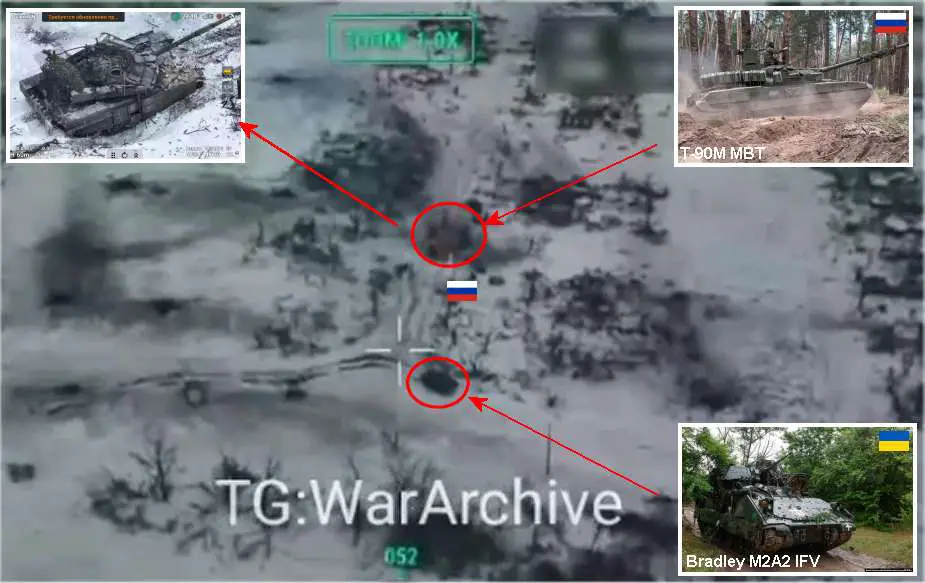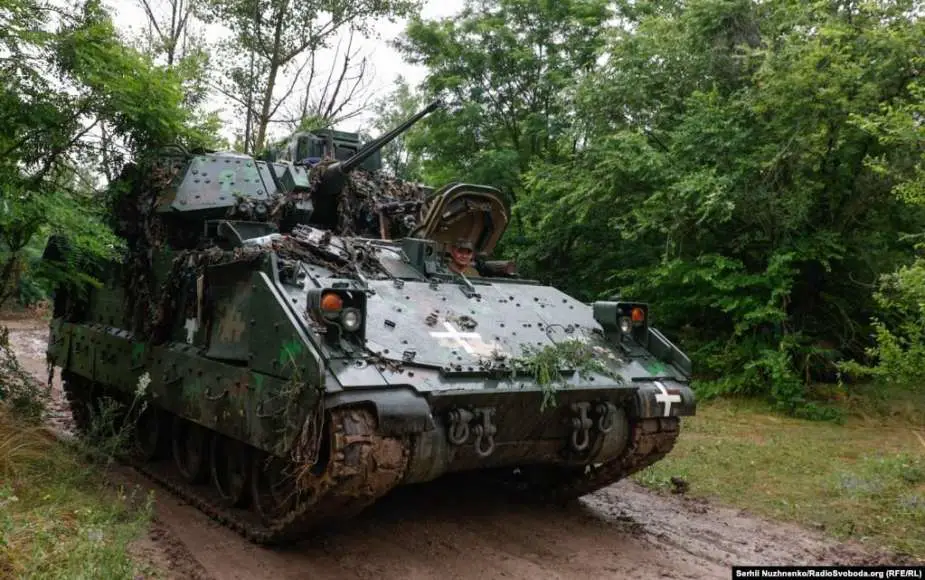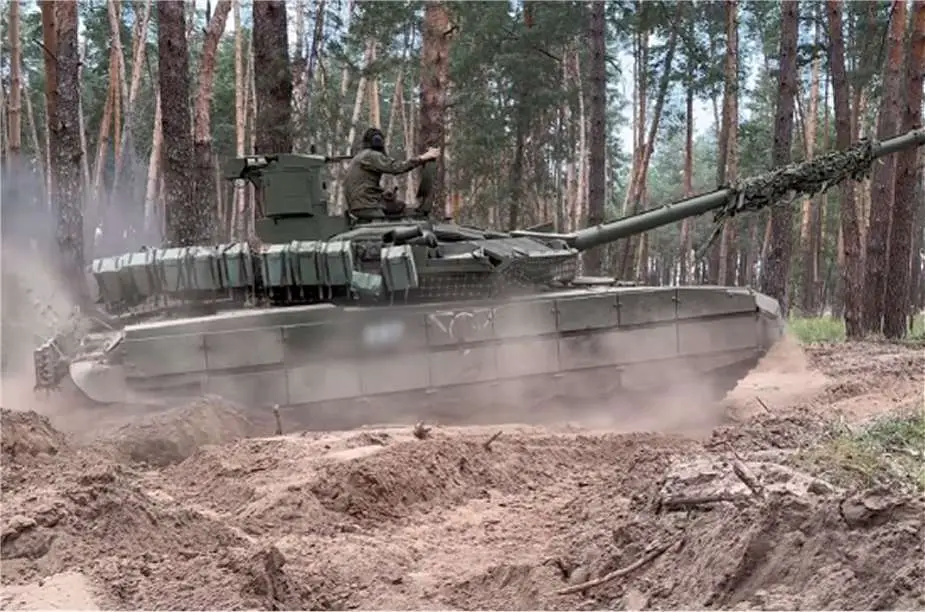Breaking News: Two Ukrainian Bradley M2A2 IFVs Destroy Russian T-90M Tank in Close-Quarter Combat
An amazing video released on Telegram has captured tense and intense close-quarter combat between two Ukrainian Bradley M2A2 tracked armored IFVs (Infantry Fighting Vehicles) and one RussianT-90M MBT (Main Battle Tank), showcasing the effectiveness of U.S.-donated military equipment in the ongoing Russian-Ukrainian conflict. The footage, captured by a drone on January 11, 2024, documents a ten-minute skirmish near Stepovo, in the Donetsk region, where the 47th Ukrainian Mechanized Brigade, equipped with Bradley M2A2 tracked armored Infantry Fighting Vehicles (IFVs), engaged a Russian T-90 Main Battle Tank.
Follow Army Recognition on Google News at this link

A Ukrainian US-donated Bradley M2A2 IFV Infantry Fighting Vehicle fires on a Russian T-90M tank in a Close-Quarter Combat. (Picture source drone video footage January 11, 2024)
In what military analysts are calling a significant display of tactical prowess, the Ukrainian brigade successfully destroyed the T-90M tank using the 25mm cannon of the Bradley M2A2 IFV. This encounter highlights the crucial role of foreign military aid in bolstering Ukrainian defenses against Russian aggression. The M2A2 Bradley IFV, a staple in the U.S. military's arsenal, has proven to be a formidable asset for Ukrainian forces, offering both mobility and firepower in the challenging terrain of the Donetsk region.
The video, which has rapidly gained attention on social media and among defense circles, provides a rare and unfiltered glimpse into the realities of modern armored warfare. Experts note that the success of the Ukrainian brigade in this encounter is not just a testament to the capabilities of the Bradley IFV but also reflects the high level of training and resilience of the Ukrainian soldiers.
The remarkable success of two Bradley IFVs (Infantry Fighting Vehicles), armed with 25mm cannons, against a Russian T-90M tank in close-quarter combat is a subject of keen interest in military analysis. This outcome, while unexpected given the conventional capabilities of the involved armaments, can be explained through a combination of tactical acumen and situational factors.
At the heart of this success lies the tactical advantage and maneuverability of the Bradley IFVs. In close-quarter scenarios, the ability to quickly maneuver and position oneself is crucial. The Bradleys, known for their agility, may have been able to exploit the relatively less agile nature of the T-90M tank. By outmaneuvering the tank and possibly attacking from angles where the tank's armor is weaker, such as the sides or rear, they could have delivered effective fire.
The rate of fire of the Bradley's M2A2 25mm Bushmaster cannon is also a significant factor. In a close-quarters engagement, the ability to rapidly discharge a large volume of rounds can be decisive. This high rate of fire might have allowed the Bradleys to exploit brief moments of vulnerability in the T-90M’s defenses, overwhelming its ability to respond effectively.
Another aspect to consider is the specific type of ammunition used. While standard rounds from a 25mm cannon might not typically penetrate the advanced armor of a T-90M, the use of specialized armor-piercing rounds could have played a crucial role. These rounds, designed to penetrate armor, might have been effective against less protected areas of the tank.
The engagement's success also speaks to the skill and experience of the Bradley crews. Effective targeting, especially in a high-stress, close-quarter combat scenario, requires precision and quick decision-making. The crews might have identified and exploited the T-90M’s operational and defensive weaknesses, targeting critical components such as vision blocks, sensors, or tracks to immobilize or impair the tank.
Coordination between the two Bradleys would have been essential in this scenario. A synchronized attack, with both vehicles targeting different parts of the tank or engaging from different angles, would increase the chances of successful penetration or infliction of critical damage.
Lastly, the element of surprise should not be underestimated. In close-quarter combat, the side that manages to surprise its opponent often gains a significant advantage. The Bradley crews might have used elements of stealth or deception to catch the T-90M off-guard, thereby maximizing the impact of their attack.
In conclusion, the success of the Bradley M2A2 IFVs against the T-90M tank in close-quarter combat can be attributed to a blend of tactical maneuvering, rate of fire, ammunition type, crew proficiency, coordinated attack strategies, and possibly the element of surprise. This engagement underscores the complex nature of armored warfare, where outcomes are often determined by more than just the technical specifications of the weapons involved.

Ukrainian Bradley M2A2 tracked armored IFV Infantry Fighting Vehicle. (Picture source Social Network)
The M242 25mm Bushmaster Chain Gun, mounted on armored vehicles such as the Bradley M2A2 Fighting Vehicle and the LAV-25, is renowned for its formidable firepower and adaptability in various combat scenarios. Its ability to engage tanks effectively depends on the ammunition type, engagement range, and the targeted tank's specific vulnerabilities.
The Bushmaster boasts a significant rate of fire, usually around 200 rounds per minute. This rapid-fire capability is particularly useful in targeting fast-moving objects or in situations where a high volume of fire is needed to suppress or destroy enemy positions. The gun's design allows for both single-shot and automatic fire modes, offering flexibility depending on the tactical situation.
In terms of ammunition, the M242 can fire a range of specialized rounds. The most common types include the M791 Armor-Piercing Discarding Sabot (APDS), designed to penetrate armored targets, and the M792 High Explosive Incendiary with Tracer (HEI-T) rounds, effective against lighter vehicles and infantry. The APDS rounds are particularly relevant in engagements against tanks, as they are capable of piercing armor, though their effectiveness varies based on the range and the armor thickness of the target.
The M791 Armor-Piercing Discarding Sabot (APDS) round, used in the M242 25mm Bushmaster Chain Gun, is designed to penetrate armor by using a high-velocity, kinetic energy penetrator. However, its effectiveness against modern main battle tanks like the Russian T-90M is limited due to the advanced armor systems these tanks employ.
The gun's accuracy and range also play a crucial role in its combat effectiveness. The M242 is known for its precision, which is enhanced by advanced fire-control systems on the vehicles it equips. However, its effectiveness against heavily armored main battle tanks is limited. The Bushmaster is more suited to engaging lighter armored vehicles, fortifications, and infantry.

Russian army T-90M MBT Main Battle Tank. (Picture source Russian MoD)

The Russian T-90M tank destroyed after the fight against the Ukrainian Bradley M2A2 IFVs Infantry Fighting Vehicles. (Picture source video footage)
News Russia Ukraine War























